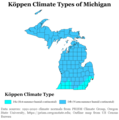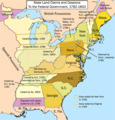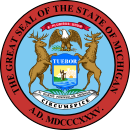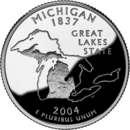Portal:Michigan
The Michigan Portal  Michigan (/ˈmɪʃɪɡən/ MISH-ig-ən) is a state in the Great Lakes region of the Upper Midwest region of the United States. It borders Wisconsin to the northwest in the Upper Peninsula, and Indiana and Ohio to the south in the Lower Peninsula; it is also connected by Lakes Superior, Michigan, Huron, and Erie to Minnesota and Illinois, and the Canadian province of Ontario. With a population of nearly 10.12 million and an area of 96,716 sq mi (250,490 km2), Michigan is the 10th-largest state by population, the 11th-largest by area, and the largest by area east of the Mississippi River. Its capital is Lansing, and its largest city is Detroit. Metro Detroit is among the nation's most populous and largest metropolitan economies. The name derives from a gallicized variant of the original Ojibwe word ᒥᓯᑲᒥ (mishigami), meaning "large water" or "large lake". Michigan consists of two peninsulas. The Lower Peninsula resembles the shape of a mitten, and comprises a majority of the state's land area. The Upper Peninsula (often called "the U.P.") is separated from the Lower Peninsula by the Straits of Mackinac, a five-mile (8 km) channel that joins Lake Huron to Lake Michigan. The Mackinac Bridge connects the peninsulas. Michigan has the longest freshwater coastline of any political subdivision in the United States, being bordered by four of the five Great Lakes and Lake St. Clair. It also has 64,980 inland lakes and ponds. Michigan has the second-most water area of any state, behind only Alaska. The area was first occupied by a succession of Native American tribes over thousands of years. In the 17th century, French explorers claimed it as part of the New France colony, when it was largely inhabited by Indigenous peoples. French and Canadian traders and settlers, Métis, and others migrated to the area, settling largely along the waterways. After France's defeat in the French and Indian War in 1762, the region came under British rule. Britain ceded the territory to the newly independent United States after its defeat in the American Revolutionary War. The area was part of the larger Northwest Territory until 1800, when western Michigan became part of the Indiana Territory. Michigan Territory was formed in 1805, but some of the northern border with Canada was not agreed upon until after the War of 1812. Michigan was admitted into the Union in 1837 as the 26th state, a free one. It soon became an important center of industry and trade in the Great Lakes region, attracting immigrants in the late 19th and early 20th centuries from many European countries. Immigrants from Finland, Macedonia, and the Netherlands were especially numerous. Migration from Appalachia and of Black Southerners as part of the Great Migration increased in the 1930s, with many settling in Metro Detroit. Although Michigan has developed a diverse economy, in the early 20th century it became widely known as the center of the U.S. automotive industry, which developed as a major national economic force. It is home to the country's three major automobile companies (whose headquarters are all in Metro Detroit). Once exploited for logging and mining, today the sparsely populated Upper Peninsula is important for tourism because of its abundance of natural resources. The Lower Peninsula is a center of manufacturing, forestry, agriculture, services, and high-tech industry. (Full article...) Entries here consist of Good and Featured articles, which meet a core set of high editorial standards.
USS Michigan (BB-27), a South Carolina-class battleship, was the second ship of the United States Navy to be named in honor of the 26th state. She was the second member of her class, the first dreadnought battleships built for the US Navy. She was laid down in December 1906, launched in May 1908, and commissioned into the fleet 4 January 1910. Michigan and South Carolina were armed with a main battery of eight 12-inch (305 mm) guns in superfiring twin gun turrets; they were the first dreadnoughts to feature this arrangement. Michigan spent her career in the Atlantic Fleet. She frequently cruised the east coast of the United States and the Caribbean Sea, and in April 1914 took part in the United States occupation of Veracruz during the Mexican Civil War. After the United States entered World War I in April 1917, Michigan was employed as a convoy escort and training ship for the rapidly expanding wartime navy. In January 1918, her forward cage mast collapsed in heavy seas, killing six men. In 1919, she ferried soldiers back from Europe. The ship conducted training cruises in 1920 and 1921, but her career was cut short by the Washington Naval Treaty signed in February 1922, which mandated the disposal of Michigan and South Carolina. Michigan was decommissioned in February 1923 and broken up for scrap the following year. (Full article...)Selected picture - The Porcupine Mountains, or Porkies, are a group of small mountains spanning across the northwestern Upper Peninsula of Michigan in Ontonagon and Gogebic counties, near the shore of Lake Superior. The area is part of the Porcupine Mountains Wilderness State Park. Did you know -
Related portalsSelected article - The metropolitan area surrounding and including Detroit, Michigan, is a ten-county area with a population of over 5.9 million, a workforce of 2.6 million, and about 347,000 businesses. Detroit's six-county Metropolitan Statistical Area has a population of about 4.3 million, a workforce of about 2.1 million, and a gross metropolitan product of $200.9 billion. Detroit's urban area has a population of 3.9 million. A 2005 PricewaterhouseCoopers study estimated that Detroit's urban area had a gross domestic product of $203 billion. About 180,500 people work in downtown Detroit, comprising one-fifth of the city's employment base. Metro Detroit has propelled Michigan's national ranking in emerging technology fields such as life sciences, information technology, and advanced manufacturing; Michigan ranks fourth in the U.S. in high tech employment with 568,000 high tech workers, which includes 70,000 in the automotive industry. Michigan typically ranks third or fourth in overall research and development expenditures in the United States. Metro Detroit is the second-largest source of architectural and engineering job opportunities in the U.S. Detroit is known as the automobile capital of the world, with the domestic auto industry primarily headquartered in Metro Detroit. As of 2003, the Alliance of Automobile Manufacturers claimed that new vehicle production, sales, and jobs related to automobile use account for one of every ten jobs in the United States. (Full article...)Selected biography -
Tony Boles (born December 11, 1967) is an American former professional football player who was a running back and kick returner who was drafted by the Dallas Cowboys of the National Football League (NFL). After starring in college football for the Michigan Wolverines, where he once led the Big Ten Conference in rushing, he went on to a scandal ridden life. His college football career was ended prematurely due to a knee injury. He has been sentenced to prison multiple times and placed in homes for addicts due to cocaine abuse. (Full article...)
General imagesThe following are images from various Michigan-related articles on Wikipedia.
TopicsCategoriesSymbols
Lists
Related pagesWikimediaThe following Wikimedia Foundation sister projects provide more on this subject:
Things you can doDiscover Wikipedia using portals | ||||||||||||||||||||||||||||||||||||









































































